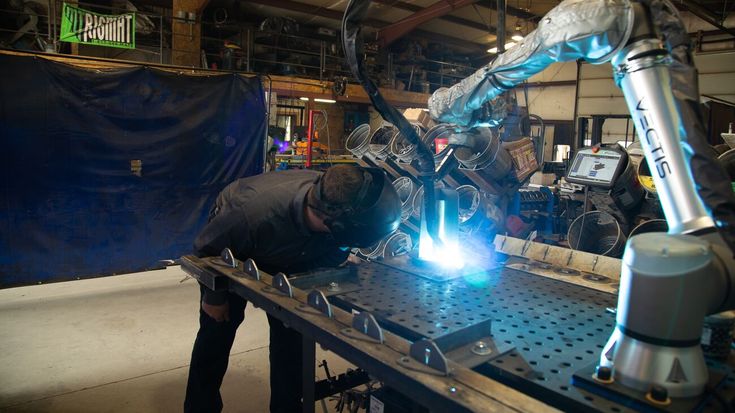Without welders the world would fall apart. Literally. With welding jobs being crucial for communities across the world, demand for welders is only set to grow over the next decade
How collaborative robots are changing the ancient art of welding

Without welders the world would fall apart. Literally. With welding jobs being crucial for communities across the world, demand for welders is only set to grow over the next decade.
Welding is synonymous with our built world and has ancient roots, with the earliest examples of pressure or forge welding coming from around 3000 BCE. At first, two pieces of metal were heated and hammered together to create a solid bond. Welding as we would recognize it today can be traced back to the late 19th century with the invention of electrical welding. Nowadays, according to one market research report, the industry is set to reach a market size of around $28.66 billion around the world by 2028.
But the industry’s workforce has an uncertain future. According to the American Welding Society, by 2026, 336,000 new welding professionals will be needed in the US. Similar shortages are felt across the world.
The art of welding
Welding is more than connecting pieces of metals together. It is both technical and creative, requiring a trained human eye and impressive manual dexterity for the most complex metal welds. It takes several years to master the art of welding and acquire sufficient experience to gain the trust and accolade of companies and fellow experts. With the creativity and passion that it constitutes, welding is worthy to be called an art form.
However, it’s not without its challenges. The work itself is dangerous in nature, requiring welders to be up close with extremely high temperatures, molten materials and welding fumes. The work can also be repetitive, involving long simple welds or hundreds of identical welds. Perhaps unsurprisingly, there are fewer young people going into welding and developing these skills. Like some other trades, the profession suffers from something of an image problem and the skill involved isn’t widely appreciated.
This is leading to a skills shortage, and as the ageing welding workforce retires, it’s becoming harder to meet rising demand for welding. Where do welders fit in the modern economy? They are a critical part of so many industries. This includes heavy industry and metal fabrication, appliance manufacturing, energy, infrastructure, heating, ventilation and air conditioning and construction. A shortage of welders could even threaten the implementation of major infrastructure projects, such as laying new pipes for district heating or building windmills.
But what if welders could find better tools to make the conditions and workload of the job more satisfying? This is where robots come in.

The evolution of welding: what’s next?
Automated welding has existed for several decades, though for a long time it was available only for specific use cases. For example, huge robots were created to help weld the inside of ships in the 1980s. Industrial automation was initially a viable option only for large companies operating in high volume, low mix environments. Nevertheless, the overall market for welding cobots in substantial. According to the International Federation of Robotics, welding applications represented almost one in five of all new robot installations in 2021 and were mainly used in the automotive industry.
But, with so much nuance and skill involved, tackling the skills shortage by completely replacing humans with automated welding machines is not the answer. The industry needs a collaborative approach; one that can help augment welders’ productivity.
A collaborative automation approach, where welders work alongside smaller robots, could help solve the skills shortage in welding. As Josh Pawley, VP of Business Development, North American based welding integrator Vectis Automation points out, “Folks aren’t going to come into the industry to weld 400 brackets a day; but they might come into industry if they’re tasked with the challenge to use collaborative automation tools to weld those 400 brackets in a third of the time.”
“This next wave of collaborative automation is helping offload the mundane and increase productivity, while simultaneously freeing skilled welders to focus on those weldments that actually require their artistry – a win for the business, and a win for the employee.”
Automation of this kind is offering this ancient trade a chance to pass on some of the most repetitive welds to robots. Human efforts can instead be focused on creating more complex and artistic metal work; jobs only experts can do. After all, welding is not just about meeting production demand. The industry demands creativity and problem-solving skills to create quality output. This is where a robot collaborating with a skilled human welding workforce can add real value, while also creating safer working environments.

Unlocking the power of collaborative welding
Yet, even with widely available technology in place, the use of collaborative automation for welding has been relatively slow to take off. When smaller collaborative robots were first introduced to industry in the early 2000s, welding was thought to be an impossibly difficult task for lighter robots. As a result, collaborative robot (cobot) welding has only started to become more widespread in the last five years, following impressive innovation across a number of different welding companies.
Josh Pawley at Vectis Automation argues this shift is a direct result of the labor market. “With manufacturing increasingly competing for talent, and ageing workforces having an impact too, more companies are turning to automation out of business continuity and necessity – which is a very interesting shift from than the traditional financial ROIs that so often justified automation (and still do).”
Delayed adoption is partly a matter of awareness and partly due the perceptions of welders – who are skilled tradespeople. It’s arguably harder to see the role of automation in a craft like welding, than in some other manufacturing activities, such as lifting, packing and dispensing. But in reality, a cobot is just a tool, similar to a painter and his brush, or a baker and his mixer. Its main purpose is to complete repetitive tasks, rather than taking over the artistic element of the role.
This is a sentiment echoed by Will Healy III, Global Welding Segment Manager, Universal Robots, who states that, “We must not forget welders see themselves as artists - and rightly so – but a shrinking workforce and growing demand for welding skills means the craft needs to evolve.”
“Working closely with welders, I’m seeing the ways in which automation could add serious value to welders’ experiences at work. Seeing cobots as a fantastic additional tool for their toolkit means they can put their expertise to best use and essentially create more art in future.”
With the demand for high mix and low volume metalwork rising, and a growing shortage of skilled workers, manufacturers should put collaborative welding at the forefront of evolving their sector. With accessible technology in place, the trade will be well placed to meet future challenges head on

Sparking a welding revolution
For an industry that’s thousands of years old, welding has remained in many ways surprisingly traditional – considering that the world’s most cutting-edge engineering and construction projects are reliant on it. Now, in the face of an ageing workforce and low numbers of new trainees entering the profession, the welding industry has an opportunity to shore up its future by combining forces with cobot technology. Industry experts see arcwelding, MIG and TIG welding as the first focus for collaborative welding techniques, with plasma cutting, grinding and laser and spot welding fast following.
Not only can cobots empower welders to make more of their art, they are also improving job satisfaction for welders. They are removing the repetitive and dangerous parts – putting skilled tradespeople first so they can get on with the task at hand. Welders using cobots keep their creative freedom, and they are still needed to teach the cobot where to weld and what weld parameter ‘recipes’ to apply.
By easing the physical strain and monotony of certain welding work, cobots could help to tackle workforce shortages in the profession by keeping experienced welders working for longer and bringing in younger talent that is excited by the prospect of using collaborative technology.
Because of this – and similar to all good welds – the welding industry could have a very bright and solid future ahead of it.

- Universal Robots USA, Inc
- 27175 Haggerty Road, Suite 160
- 48377 Novi, MI